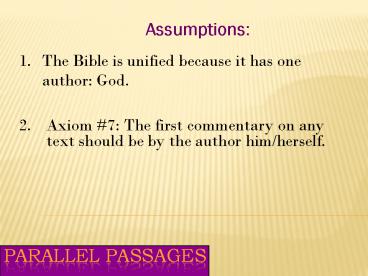Parallel Passages PowerPoint PPT Presentation
Title: Parallel Passages
1
Parallel Passages
Assumptions
- 1. The Bible is unified because it has one
author God.
2. Axiom 7 The first commentary on any text
should be by the author him/herself.
2
Parallel Passages
Types of Parallels
- 1. Synoptic parallels Matthew, Mark, and Luke.
2. OT quotes All NT books except Philemon and
1-3 John have them.
3. Chronological parallels Epistles and Acts.
4. Prophetic vocabulary and symbols Ex. Acts
216-21 Joel 228-32.
5. Topical parallels Suffering, women, eternal
security, divorce, second coming, baptism, etc.
3
Parallel Passages
How to Find Parallels
1. Read your Bible extensively.
2. Use the marginal notes.
- Use Topical Bibles. Naves http//studylight.o
rg/con/ntb/Treasury http//studylight.org/con/ts
k/
4. Use a computer concordance.
4
Project 7
- Write a commentary on your text using nothing but
parallel passages. This is not a comprehensive
commentary, but one which addresses specific
theological issues that arise either from
words/phrases or from ideas in your text.
Identify an issue in your text you want to
investigate. Then find 5-10 parallel passages
which speak to that issue. In a paragraph,
summarize what the Bible says about this topic.
Repeat this exercise for three topics in your
text.
5
Parallel Passages
Guidelines for Interpretation
1. Dont abuse lists of Scripture.
a. Allow each text to stand on its own.
b. Dont force a text to stand next to another if
it doesnt want to.
c. Prioritize later revelation over earlier
revelation.
d. Repeated passages get priority over single
texts.
e. Be cautious about lists.
6
Parallel Passages
Guidelines for Interpretation
2. Harmonize appropriately Scriptures that appear
to stand in contradiction.
a. If the author has a track record for honesty
and credibility, make every effort to reconcile
his/her accounts.
b. If a reasonable explanation exists, the author
cannot be charged with error.
c. He who asserts must also prove.
d. It takes mutually exclusive accounts to be
irreconcilable.
PowerShow.com is a leading presentation sharing website. It has millions of presentations already uploaded and available with 1,000s more being uploaded by its users every day. Whatever your area of interest, here you’ll be able to find and view presentations you’ll love and possibly download. And, best of all, it is completely free and easy to use.
You might even have a presentation you’d like to share with others. If so, just upload it to PowerShow.com. We’ll convert it to an HTML5 slideshow that includes all the media types you’ve already added: audio, video, music, pictures, animations and transition effects. Then you can share it with your target audience as well as PowerShow.com’s millions of monthly visitors. And, again, it’s all free.
About the Developers
PowerShow.com is brought to you by CrystalGraphics, the award-winning developer and market-leading publisher of rich-media enhancement products for presentations. Our product offerings include millions of PowerPoint templates, diagrams, animated 3D characters and more.

